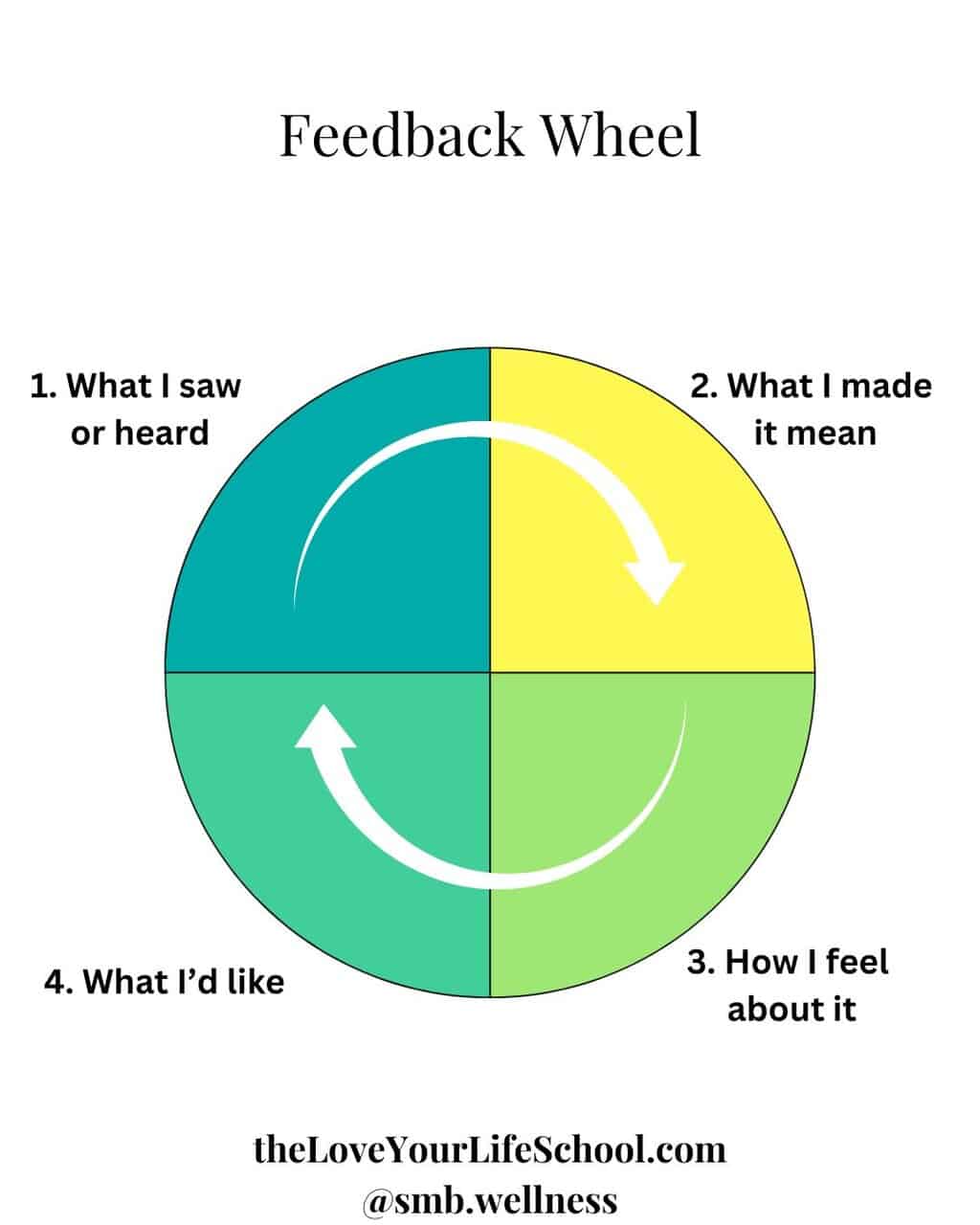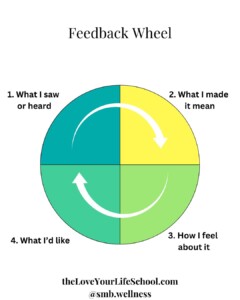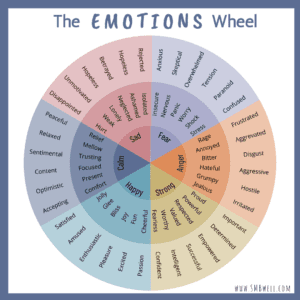Podcast: Play in new window | Download
Subscribe: Apple Podcasts | Spotify | Amazon Music | RSS | More
Use the Feedback Wheel to Have Conversations Without Blame or Defensiveness
Relationships shape our emotional and even physical well-being. Thriving connections often leave us feeling lighter, more energized, and happier. However, tension, unspoken frustrations, or conflict can weigh us down in ways we might not even recognize.
If you’ve ever felt physically unwell during times of relationship stress, you’re not alone. Many of us have been conditioned to believe that physical symptoms must have physical causes. But what if your neck stiffness isn’t just from sleeping wrong but from avoiding a difficult conversation? Could your exhaustion stem not only from lack of sleep but also from the emotional weight of unspoken resentments?
Thankfully, there’s a tool that can help: The Feedback Wheel. This simple four-step framework will help you communicate your thoughts and feelings in a way that invites connection rather than defensiveness. Whether it’s a conversation with your spouse, teen, coworker, or friend, learning this method can make difficult conversations easier and more productive.
Why We Struggle with Communication
Many of us shy away from difficult conversations, fearing conflict or wanting to maintain harmony. Some of us suppress our feelings until they erupt, while others try to share their thoughts but end up feeling ignored or misinterpreted. Still, some might over-explain, grow defensive, or shut down completely.
These communication habits often root back to past experiences where speaking up felt unsafe. Whether in childhood or previous relationships, we may have learned that voicing our concerns led to rejection, anger, or punishment.
The good news? These patterns aren’t permanent—they can be unlearned.
The Feedback Wheel is a tool that fosters mature communication: calm, clear, and direct, without resorting to blame, shame, or manipulation
Step 1: Prepare Yourself
Before you start the conversation, check in with yourself.
Are you operating from your adult brain or your child’s brain? Tune in to this episode of the Love Your Life Show to learn how to distinguish between the two. Once you can identify whether you’re in your activated child mode or your wise adult state, make sure you’re grounded in your adult brain before having this conversation. Listen in to this week’s episode of the show to learn ways I get myself into my adult brain.
Step 2: Consent
Seek Permission Before Talking.
Rather than diving into a tough conversation when it feels urgent to you, first ask the other person if they’re available to talk.
This simple step helps reduce defensiveness and sets the stage for a more constructive dialogue.
Here are some ways you could do this:
With your teen: “I’d like to talk about your homework. Is now a good time?”
And with your spouse: “Hey, could we discuss how we’re dividing household tasks? Are you free to chat right now?”
If they say no, that’s okay. Simply ask, “When would be a good time?” and honor their response.
Time for the Conversation! The Feedback Wheel
Once you’re in your adult brain and have permission, it’s time to use the feedback wheel:
Just the Facts: Think of this like a video camera recording the situation. What actually happened? Keep it neutral and avoid blaming language. I give real life examples in this week’s episode of the Love Your Life Show.
What You Made it Mean: Brene Brown labels this part: “the story you’re telling yourself” about the facts that happened. We all interpret events in our own way. In one or two sentences, share your interpretation of what happened.
What that looks like is instead of saying: “You don’t respect me.” Instead you say something like “when I saw the dishes in the sink, the story I told myself was that you don’t care about helping out around the house.”
This keeps the focus on your experience rather than blaming the other person.
How You Feel
Describe how you feel in just one or two words.
If you’re unsure how to distinguish feelings from thoughts, grab the podcast roadmap.
You can also use this emotions wheel as a helpful tool to identify common feelings.
Make a Clear Request
This is the step that’s often overlooked in conversations. We voice our frustrations but fail to clearly ask for what we need. You’ll know you’re missing this step if the same argument keeps happening, or if the other person apologizes but nothing ever changes.
Tune in to the podcast episode to discover simple, effective ways to express your needs. It’s a small shift that can transform your relationships and household dynamics.
This step shifts the conversation from complaint to solution, making it easier for the other person to respond positively.
Moving Forward with the Feeling Wheel:
At first, using the Feedback Wheel may feel a bit awkward, and that’s perfectly okay.
The key is to practice—whether at work, with your teen, or even with your mom. When trying it with your spouse, start with something small to ease into the process.
Come to group coaching in the Love Your Life School and we can role play.
To support your growth:
Start by practicing in low-stakes situations.
Use the tool with a friend or coworker before applying it to more significant relationship challenges.
After each conversation, take time to reflect: What went well? What fell short? And what adjustments could you make for next time?
Life Homework:
This week, choose one conversation to try the Feedback Wheel—whether with a family member, friend, or colleague. Pay attention to how it feels to express yourself clearly and without blame.
Keep in mind, this is a skill, not something you’ll master overnight. Be kind to yourself and celebrate every step forward. Think of it like learning a new language—it takes time and practice!
I’d love to hear how it goes! If you’d like a follow-up post on healthy listening skills, leave a comment or send me a message. Let’s grow together!
For more guidance, join us in the Love Your Life School, where we explore communication and relationship skills in depth.
Remember, you don’t have to navigate this alone!
CONNECT WITH COACH SUSIE:
↻ Website







